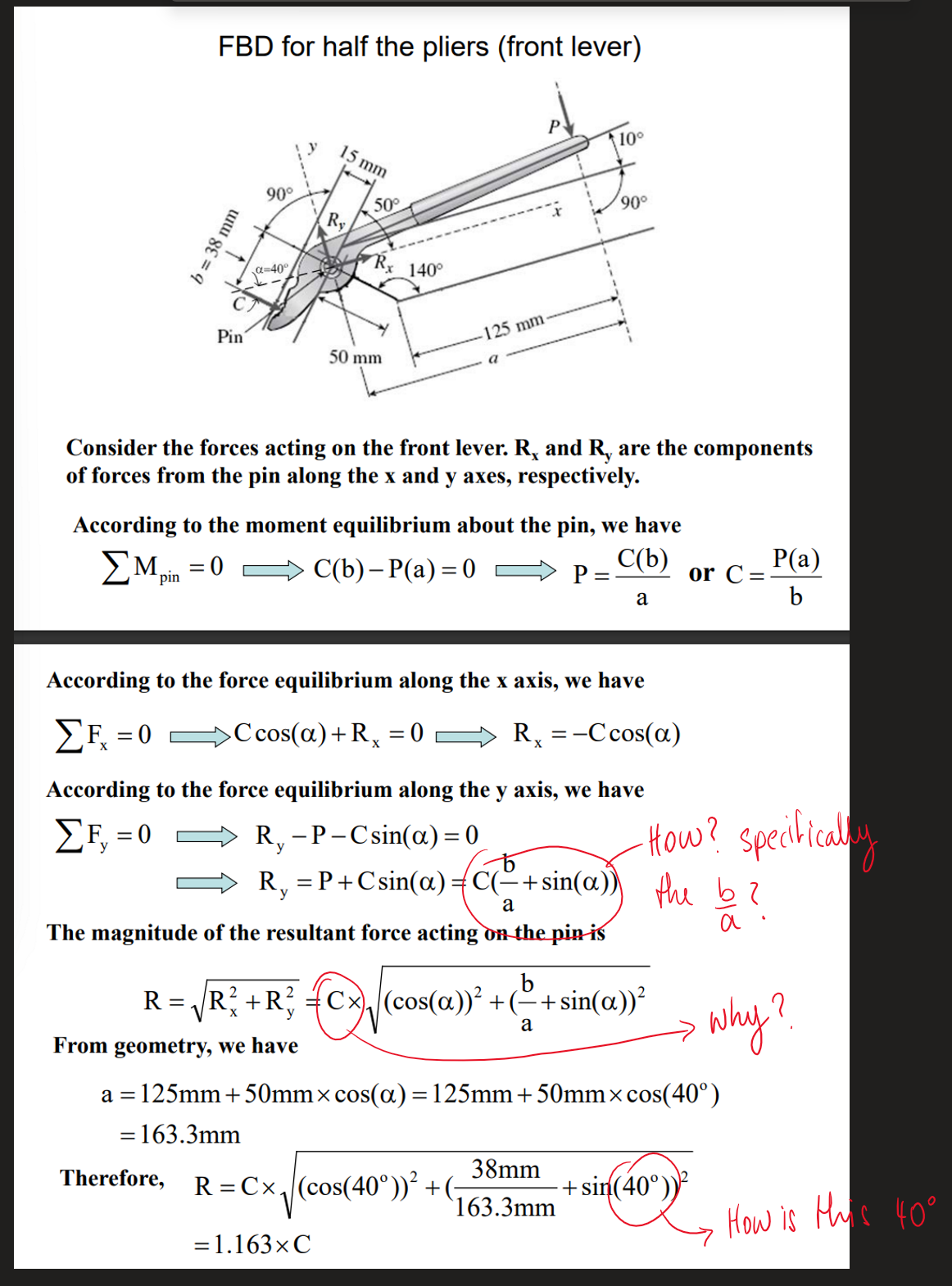FBD for half the pliers (front lever) b = 38 mm Pin 90° α-40° 15 mm Ry 50° Rx From geometry, we have 50 mm 140° 125 mm P Consider the forces acting on the front lever. R. and R, are the components of forces from the pin along the x and y axes, respectively. According to the moment equilibrium about the pin, we have ΣMpin = 0 C(b)- P(a) = 0 C(b) a 10° 90° P= = According to the force equilibrium along the x axis, we have ΣΕ = 0 >Ccos(a)+Rx = 0 Rx = -Ccos(a) According to the force equilibrium along the y axis, we have ΣF = 0 Ry -P-Csin(a)= 0 b R₁ = P + Csin(a)=C(−+sin(a)) a The magnitude of the resultant force acting on the pin is Therefore, R=Cx₁ (cos(40°))² + (; 38mm 163.3mm b R = √R² + R²} {Cx) {(cos(a))² + ( + sin(a))² a or C= How? specifically the b? a a = 125mm +50mm× cos(a) = 125mm +50mmx cos(40°) =163.3mm + sin(40°)) P(a) b why? How is this 40°
FBD for half the pliers (front lever) b = 38 mm Pin 90° α-40° 15 mm Ry 50° Rx From geometry, we have 50 mm 140° 125 mm P Consider the forces acting on the front lever. R. and R, are the components of forces from the pin along the x and y axes, respectively. According to the moment equilibrium about the pin, we have ΣMpin = 0 C(b)- P(a) = 0 C(b) a 10° 90° P= = According to the force equilibrium along the x axis, we have ΣΕ = 0 >Ccos(a)+Rx = 0 Rx = -Ccos(a) According to the force equilibrium along the y axis, we have ΣF = 0 Ry -P-Csin(a)= 0 b R₁ = P + Csin(a)=C(−+sin(a)) a The magnitude of the resultant force acting on the pin is Therefore, R=Cx₁ (cos(40°))² + (; 38mm 163.3mm b R = √R² + R²} {Cx) {(cos(a))² + ( + sin(a))² a or C= How? specifically the b? a a = 125mm +50mm× cos(a) = 125mm +50mmx cos(40°) =163.3mm + sin(40°)) P(a) b why? How is this 40°
International Edition---engineering Mechanics: Statics, 4th Edition
4th Edition
ISBN:9781305501607
Author:Andrew Pytel And Jaan Kiusalaas
Publisher:Andrew Pytel And Jaan Kiusalaas
Chapter10: Virtual Work And Potential Energy
Section: Chapter Questions
Problem 10.60P: The weightless bars AB and CE, together with the 5-lb weight BE, form a parallelogram linkage. The...
Related questions
Question
Please help explain the annotation?

Transcribed Image Text:FBD for half the pliers (front lever)
b = 38 mm
Pin
=
= 0
90°
Therefore,
α-40°
15 mm
Ry
50°
From geometry, we have
Rx
50 mm
Consider the forces acting on the front lever. R, and R, are the components
of forces from the pin along the x and y axes, respectively.
140°
According to the moment equilibrium about the pin, we have
C(b)
ΣMpin
C(b)- P(a) = 0
a
125 mm
According to the force equilibrium along the x axis, we have
ΣΕ = 0
>Ccos(a) + Rx = 0
Rx = -Ccos(a)
According to the force equilibrium along the y axis, we have
ΣF₁ = 0
R₁ - P-Csin(a) = 0
y
90⁰
P =
R₁ = P +Csin(a)=C(=+sin(a))) the b
y
a
The magnitude of the resultant force acting on the pin is
a
b
R = √ R² + R² Cx)√ (cos(a))² + (−+sin(a))²
{cx
a
R = Cx₁ (cos(40°))² + (;
= 1.163× C
38mm
163.3mm
or C=
a = 125mm +50mm× cos(a) = 125mm +50mm× cos(40°)
=163.3mm
-How? specifically
+ sin(40°))
P(a)
b
why?
How is this 40°
Expert Solution
This question has been solved!
Explore an expertly crafted, step-by-step solution for a thorough understanding of key concepts.
This is a popular solution!
Trending now
This is a popular solution!
Step by step
Solved in 3 steps with 3 images

Knowledge Booster
Learn more about
Need a deep-dive on the concept behind this application? Look no further. Learn more about this topic, mechanical-engineering and related others by exploring similar questions and additional content below.Recommended textbooks for you

International Edition---engineering Mechanics: St…
Mechanical Engineering
ISBN:
9781305501607
Author:
Andrew Pytel And Jaan Kiusalaas
Publisher:
CENGAGE L

International Edition---engineering Mechanics: St…
Mechanical Engineering
ISBN:
9781305501607
Author:
Andrew Pytel And Jaan Kiusalaas
Publisher:
CENGAGE L